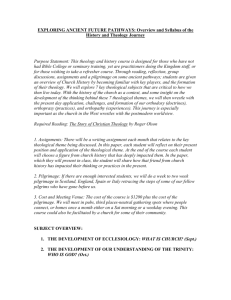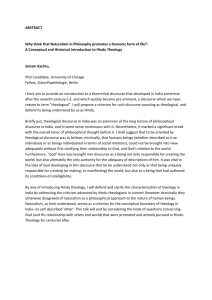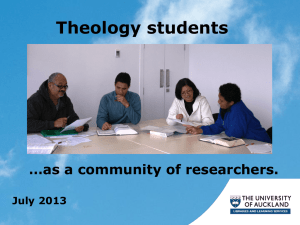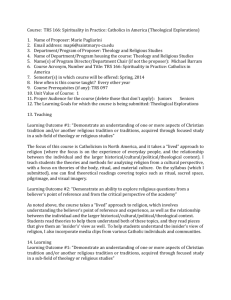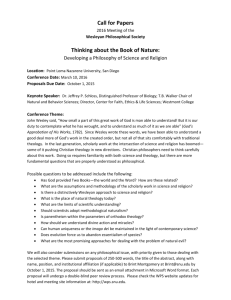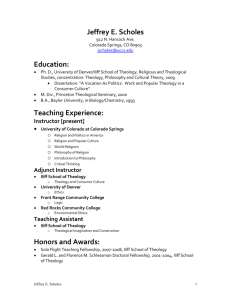Radical Orthodoxy's Critique of Transcendental
advertisement
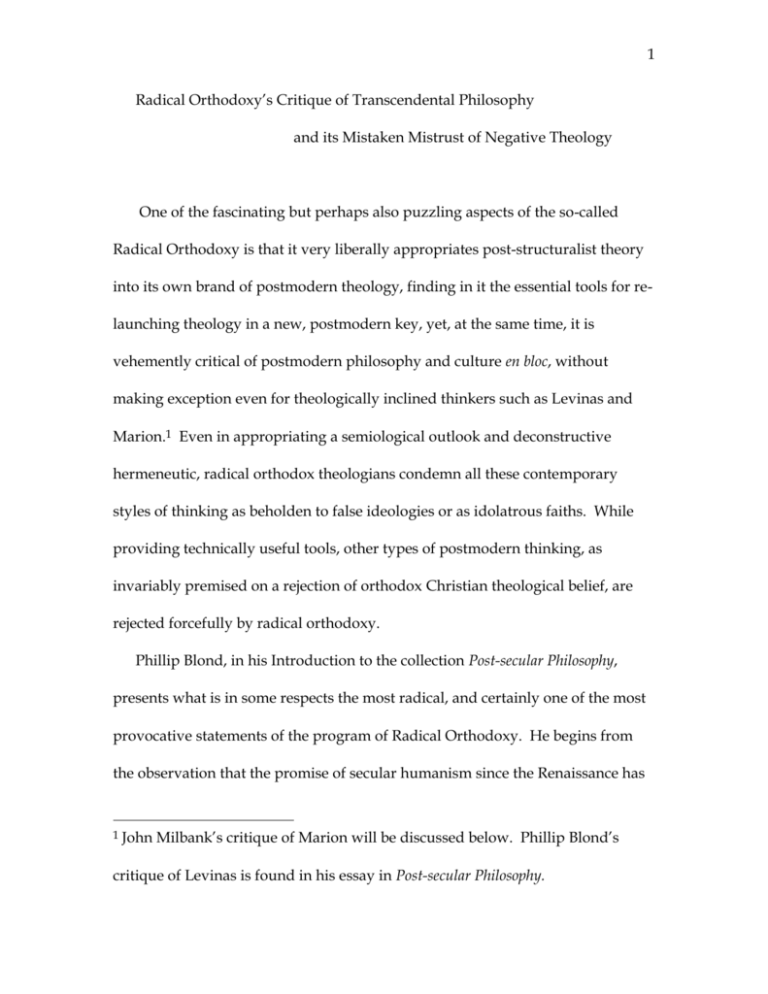
1 Radical Orthodoxy’s Critique of Transcendental Philosophy and its Mistaken Mistrust of Negative Theology One of the fascinating but perhaps also puzzling aspects of the so-called Radical Orthodoxy is that it very liberally appropriates post-structuralist theory into its own brand of postmodern theology, finding in it the essential tools for relaunching theology in a new, postmodern key, yet, at the same time, it is vehemently critical of postmodern philosophy and culture en bloc, without making exception even for theologically inclined thinkers such as Levinas and Marion.1 Even in appropriating a semiological outlook and deconstructive hermeneutic, radical orthodox theologians condemn all these contemporary styles of thinking as beholden to false ideologies or as idolatrous faiths. While providing technically useful tools, other types of postmodern thinking, as invariably premised on a rejection of orthodox Christian theological belief, are rejected forcefully by radical orthodoxy. Phillip Blond, in his Introduction to the collection Post-secular Philosophy, presents what is in some respects the most radical, and certainly one of the most provocative statements of the program of Radical Orthodoxy. He begins from the observation that the promise of secular humanism since the Renaissance has 1 John Milbank’s critique of Marion will be discussed below. Phillip Blond’s critique of Levinas is found in his essay in Post-secular Philosophy. 2 not been fulfilled. Human beings have shown themselves not to be the measure of things; they have proved unable to “provide their own calibration” (p. 2). The evidence of this is all about us in a contemporary culture that burgeons in every imaginable variety of nihilism. The violence and perversity of contemporary history is adduced to demonstrate the vanity of any culture not based on recognition of theological transcendence, on faith in God. With regard to philosophy, the various secular proxies for a transcendent ground or principle of reality—Blond lists language, pragmatics, power—all collapse back into immanence as pure projections of human will to dominate the world and be the master of itself. And the attempt consistently proves futile in its Narcissism and circularity: only the nothingness of human existence without a truly transcendent ground becomes manifest. In this manner, Blond describes how modernity closes out the purportedly true transcendence represented by God the Creator through putting various a priori principles in his place, principles that claim to be transcendental conditions of discourse and to adjudicate claims to truth, though they are but projections and are made by human minds. To this extent, they are like the idols of human handiwork abominated by the prophets of the Old Testament. The wages of such transcendental (and Kantian) thinking, whereby human beings usurp for themselves and their conceptual artifacts the transcendent status that belongs by rights to God alone, are death and nihilism. 3 Nor apparently, according to these late moderns, can a transcendent value escape any of the contemporary surrogates—language, pragmatics, power—which transcendental thinking has engendered in order to preserve itself. These proxies, foreclose upon any other possibility. No, their advocates say, ‘your values are ancillary to this, in respect of this discernment everything else is subordinate, this is the prior discourse that secures our descriptions, and we, we who ascertained this, we are the authors and judges of this world and there is no other’ (p. 2). This is obviously caricature, whether or not it is found to be persuasive. The dialogical style is in itself highly significant. The point of such post-secular philosophy derives from its negation of the type of thinking it characterizes as secular and accuses of “self-mutilation.” We will need to ask, however, whether such a wholesale dismissal of modern culture is not itself something of a selfmutilation. Blond takes up a sometimes contemptuous tone and embattled stance, which cannot possibly produce the harmony and reconciliation envisaged by Christian faith as he describes it. He begins, “We live in a time of failed conditions. Everywhere people who have no faith in any possibility, either for themselves, each other, or for the world, mouth locutions they do not understand. With words such as ‘politics’, they attempt to formalise the unformalisable and found secular cities upon it” (p. 1). 4 Blond’s reference to the “unformalizable” is a first significant clue as to how a theological vision of transcendence can be recuperated, namely, through acknowledging the inadequacy of all our human formulations. Hence the accent on “indeterminacy” of theological representation that is a keynote also of John Milbank’s writings. This is what secular reason cannot positively define. It is the object of faith and conjecture. It has been the peculiar concern of traditional negative theology. However, it is not these ironically positive resources within Christian tradition that Blond turns to and builds on. He prefers to proceed polemically, by attacking and attempting to invalidate all forms of secular rationality. Even in proclaiming a positive, phenomenological gift and original basis in theological perception, a theological “sensorium,” it is with constant reference to what it rejects that this philosophical theology presents and justifies itself. The irony of this is that reconciliation and harmony are touted as goals of this selfconfessed Christian philosophy. How is harmonious reconciliation to come out of virulent attack against modern culture and the greater part of thinkers in the domain of religious philosophy today? Our critical sense tells us rather that it is necessary to show another face of Christianity, one reflecting its self-abnegation, its negative theological tradition, to enable the Christic spirit of kenotic selfemptying and of reconciliation to overtake the crusading spirit of selfjustification and self–aggrandizement that have also been so much a part of the 5 history of religions including Christianity.2 An unwitholding openness to others and an acceptance of them in spite of what may be recognized as sin, first in oneself, I submit, is more the genius of Christianity that Blond too wishes to let flourish. The disturbing rift Blond opens up between secular and theological culture will make dialogue impossible, unless negative theological insight and sensibility are deployed to forestall such an impasse. Radical Orthodoxy has absorbed postmodern critical theory as critique, and it is this critical consciousness which enables it to position theology in a new, more confident and outspoken way. Enlightenment empiricist and rationalist dogmas find themselves effectively undermined by the new, broadly deconstructive criticism, in which universals have generally been exposed as forms of perpetuating violence against what they inevitably exclude. Consequently, the religious perspectives and ideologies they had suppressed find that they can breath again in the ambience newly created by postmodern critique. Much of Milbank’s work focuses on rereading modern culture with emphasis on theological thinkers such as Hamann, Vico, and Kierkegaard who were marginalized by their more secular counterparts, particularly Hegel, up until the recent turns of post-structuralism. It is really on the basis of a postmodern critique of philosophy, led particularly by French thinkers of difference like Derrida, de Certeau, Irigaray and Kristeva in the wake of the so- 2A radical orthodox approach, pivoting on kenosis, is sketched by Graham Ward, “Kenosis and Naming: Beyond Analogy and towards allegoria amoris,” 6 called linguistic turn that theology has found a new footing for itself in the outlook of Radical Orthodoxy.3 The crucial insights are found in orthodox Christian thinkers of the tradition, particularly in the eighteenth century and its “linguistic turn” with Hamann and Vico and with other “profoundly orthodox Christian thinkers.”4 The oscillations in eigtheenth-century linguistic theory between empiricism and rationalism are not, however, what is really interesting. Both philosophies were confined within the inherited metaphysics of substance. More truly significant was the break-up of this thinking, the steps towards a modern ‘linguistic turn’, beyond linguistic instrumentalism, foundational reason and nominialsit empiricism. Yet what is almost never attended to is the fact that these moves were not made by an unambiguous ‘enlightenement’, but rather by profoundly orthodox Christian thinkers—by Robert Lowth, Johann Georg Hamann, George Berkeley, Giambattista Vico and Jahann Gottfried Herder. As an experiment, I now choose to interpret this linguistic turn not as a secular phenomenon, but rather as the delayed achievement of the Christian Religion, Modernity and Postmodernity, ed. Paul Heelas (Oxford: Blackwell, 1998) 3 Graham Ward’s The Postmodern God: A Theological Reader (Oxford: Blackwell, 1997) bears significant witness in this regard. 7 critique of both the antique form of materialism, and the antique metaphysics of substance. (“The Linguistic Turn as a Theological Turn,” p. 97) Milbank traces how orthodox Christian thinkers ever since Gregory of Nyssa and Augustine have undermined substance metaphysics by a Trinitarian understanding of reality in semiotic terms as based on the Word as a paradigm of relations. They have, in effect, anticipated the linguistic turn taken by philosophy in modern times. “Christian theology has been able, like sceptical postmodernism, to think unlimited semiosis” (p. 113). Of course, in the Christian view this unlimited semiotic activity is a manifestation of something theological in essence; it is concerned with something transcendent and is not consumed merely with itself. “The contrast with postmodernism lies at the level of metasemiotics, where the nihilists seem only able to think of signified absence in terms of a necessary suppression, betrayal or subversion” (p. 112). Theology alone preserves real difference that is not reduced: For theology, and theology alone, difference remains real difference since it is not subordinate to immanent univocal process or the fate of a necessary suppression. Instead, the very possibility of substitutive 4 Milbank, “The Linguistic Turn as a Theological Turn,” Word Made Strange: Theology, Language, Culture (Oxford: Blackwell, 1997), p. 97 8 transference is here held to be a peaceful affirmation of the other, consummated in a transcendent infinity (“The Linguistic Turn as a Theological Turn,” p. 113). Signs emerge, in the tradition Milbank outlines, as mediations of the real as absolute, as theological. There is the mediation of signs in all our knowledge, which is never direct possession and presence. This cuts against Kant’s epistemological subjectivism, which makes the sign merely arbitrary and consequently makes all our knowledge only transcendentally related to things themselves as their condition of possibility. Milbank proposes rather a realist metaphysics or theological ontology that does not need to be overcome. With reference to a theory of George Berkeley’s, he makes the general point that “semiosis now involves real relations, substitutionary transitions which though inscrutable, are more than arbitrary; the signifying relation becomes also symbolic” (p. 103). The signifying relation is not empty; the symbol betokens the other half of what it has been broken off from, whereas the postmodern secularist, by contrast, is left with nothing to symbolize. Yet Milbank goes a long way in adopting the techniques of postmodernism for thinking presence in a deconstructed manner. This presence is an invisible image and is evoked by a shattered, broken sign. These terms help him to reformulate Christian doctrine on the far side of the post-structuralist critique of the sign. Christ crucified is the key to this post-secular semiotics: “One 9 paradoxical reason for our recognition of Christ as the true sign is that all the signs he offers us are broken signs that offer their own asymmetry as a testimony to their own inadequacy and to the infinite distance between humanity and God” (p. 137). Christ’s death, together with the drama of the Last Supper that enframes it, in which Christ institutes himself as a sign, opens into universal meaning. “The words of Maundy Thursday and the acts of Good Friday together compose a poetic act characterized by an ‘overtaking’, such that the intention of the sign is only realized in the full outcome of its explication” (p. 138). Jesus commits himself to “death as the reality of sign qua sign,” since the sign can become complete and defined and thereby totally significant only as “a function of its lifelessness.” It is especially Vice’s notion of language as metaphorical, with his idea of the judgment of a common sense or imagination which perceives a concrete universal, that informs Milbank’s Christological poetics. Christ is our proper word for God and for true humanity. This proper word is finally taken up into, included in, the eternal Logos of the Father. When we see Christ in the flesh, we already see this invisible centre, because our whole perception is informed by the gift of the Holy Spirit, a sensus communis inaugurated in us by Christ as an adequate sense of metaphorical judgement that is—though it is generated through it—the necessary transcendental condition for the adequate concrete universal. 10 That the concrete universal is ultimately an invisible image is already suggested to us, we may venture to say, in the diversity of reports about Christ and the sheer number of traditions that are invoked to build up this figura” (p. 140). Christ is enacted in our acts. He has no unitary presence, but is a poetic expression that proliferates in an endless series of re-enactments.5 Milbank borrows from von Balthasar the idea that the doctrine of justification can only be presented as the history of the saints. God in Christ remains per se an invisible image. Any determinate image even of the life and works of Christ himself yields its full meaning only through further images given by subsequent agents—from Saint Francis of Assisi, for example, to the mentally retarded child, perhaps—in a series in which its infinite meaning remains ever open and determined anew from new angles of vision. Salvation history thus unfolds as the “quest for the representation of the unrepresentable” (p. 131). Such is “the dialectic of human and divine history” (p. 131). It is as this divine-human person, who has both finitely and infinitely the character of a representation, that we finally recognize in Jesus the divine overtaking and fulfilling of all human purposes. As the divine utterance 5 Michel de Certeau has also developed this line of thinking, particularly in La faiblesse de croire (Paris: Seuil, 1987). 11 Jesus is the absolute origination of all meaning, but as a human utterance Jesus is inheritor of all already constituted human meanings. He is a single utterance in his unified filfilment of these meanings, such that he becomes the adequate metaphoric representation of the total human intent (p. 136). Milbank is again applying Vico’s ideas of all language as metaphorical and of metaphor as the original language of humankind. In general the semiotic vision of reality as constituted by signifying relations is basic to his radical (Trinitarian) rethinking of Christian revelation. This leads him to recognize infinite semiosis without original, pure presence as literally crucial to the poetic making of revelation. It is negative semiology since it is axised on the absolute, on God, who can never be adequately given in any sign. This also means that he recognizes what to determinate signs and language is a void at the center and origin of all that can be revealed. Milbank uses the Aristotelian idea of poiesis as producing something of value beyond the act itself, beyond praxis, to suggest how God and providence, as well as sin, work in determining the meaning and value of our actions in constructing our lives. What becomes of what we do and become reaches far beyond our own intentions and direct enactments, though we are still responsible collectively for the meanings of what becomes of what we are and do. Even before we do them our acts are conditioned in countless ways. In this sense, they “occur to us” and 12 so are open to grace (as well as distortion)—they are mediated before and after the act in ways both human and possibly divine. Milbank’s essay, “Only Theology Overcomes Metaphysics,” suggests that even the rigorous efforts of Jean-Luc Marion to escape the metaphysical determination of God by Being are all fundamentally in vain. For Milbank, Marion’s phenomenological approach to God as beyond Being, as pure Gift and Giving, remains idolatrous, indeed metaphysical in its assertion of the autonomy of philosophy. Marion takes being as univocal in the modern, idolatrous way that has prevailed since Duns Scotus, but only since him. Previous metaphysics were not independent of theology and were to this extent a poetry based on the being of God given in creation but ungraspable by our human language, though it could be poetically performed. Theology unlike philosophy is receptive to the revealed word, most profoundly through a Christological poetics. Theology receives an extra-cosmic, vatic logos and performs it poetically. But philosophy as autonomous, as ‘about’ anything independently of its creaturely status is metaphysics or ontology in the most precisely technical sense. Philosophy in fact began as secularizing immanentism, an attempt to regard a cosmos independently of a performed reception of the poetic word (p. 50). 13 Similar critiques would apply to Levinas. He too employs the transcendental method of phenomenology in an attempt disengage thinking and an ethical consciousness that is perhaps even prior to what can be called “thinking” from being and its essences. Blanchot in dialogue with Levinas has come to similar conclusions. 6 The problem with transcendentalist approaches to theology is that they set up some criterion defined by thought as determining what is beyond the range of human fashioning and thus, presumably, idolatry. But all these criteria are inevitably made in thought’s own image. Pure presence or pure giving beyond and before all categories of being simply substitute other categories that are still humanly thinkable and thought. They are determinations of divinity. God is allowed to escape from being and the categories of onto-theology, but if transcendental phenomenology or philosophy supplies some other standard, God is still measured by a humanly comprehensible standard. Only if these transcendental philosophies are interpreted apophatically, as providing metaphors which we do not understand with reference to the transcendent, but only in terms of our human languages, is the regime of a semantics embracing God and creation alike broken up. I take Levinas, Blanchot, and Marion in this 6 Some of these critical stances regarding French thinking in the wake of the death of God as transcendentalist and thus still metaphysical are worked out by essays in Post-Secular Philosophy. It includes essays by ... on ... 14 sense. Kevin Hart reads Blanchot and Marion somewhat this way.7 It is the negative theological reading that can save them from an otherwise devastating critique from Radical Orthodoxy. Marion, by rejecting the language of Being, seems to be seeking some other language that will not have the same defects and be beholden to ontotheology but will rather be adequate. But the deeper apophatic insight is that no language can be adequate to God. All language can operate only as metaphor in revelation. [Does this then set another transcendental criterion? No, to the extent that it remains apophatic and accepts the need of being conjoined externally with a kataphatic language in order to say anything at all.] Derrida’s turn to religion in his later writings is based, I believe, on this realization that no critical, philosophical language whatever could be adequate to the religious. One is within the discourse of the divine, although this discourse can then be expropriated and made strange to itself. There is no standpoint outside metaphysical discourse for making it. This critical outlook represents Radical Orthodoxy at its strongest, at least from the point of view of those who do not subscribe to its particular presuppositions of faith. It is on these critical bases that Blond can persuasively 7 15 maintain that ontology, or any other secular philosophical discourse, cannot ground itself or its world and must in the end turn to theology: “theology is the discourse about the origin of beings” (p. 12), the only valid discourse. Ontology, as the philosophical discourse about beings in general, must remain open and aporetic; it can never find the ground of beings in its own immanent sphere of being. [(This is basically the argument we have traced from Plotinus concerning “the surpassing of classical ontology” and the inability of the order of beings to achieve closure and grounding except through a principle radically transcendent to being.)] There is no ontological account of ultimate origins. Only theology can provide that. If ontology is the discourse of being qua being, an investigation of being in its most general and universal form, then without God, I would suggest, it is a discourse that cannot grasp its own essence. The undoubted profundity and weight of a secular ontology will consist only in its perpetual marking of aporias and paradoxes. For only theology can give an account of these disjunctures that allows thinking to move beyond them” (p. 12). Hence, for Blond, “The relationship that pertains for theology with respect to ontology is one of absolute superiority” (p. 12). Since ontology cannot find the ground of beings within beings themselves, any ontology must at some point 16 open towards the Transcendent and thus inevitably hand the baton to theology. Theology alone can think this Transcendent. It can be thought not in terms of self-presencing and self–concealment, which remain always on a plane of immanence, but in terms of creation ex nihilo, that is, of the unbridgeable, ontologically unmediated gap between creatures and Creator. Blond is proposing a theological discourse about the ground of beings that has no need of philosophy, that can approach this ground directly itself. I suggest, however, that this is based not only on theology’s alleged superiority but also on the premise that there is actually no proper discourse about such a ground and that therefore theology is free to approach it with metaphors, with its own symbolic vocabulary. Theology is in no better position than philosophy (ontology) to approach the transcendent with human language, unless we postulate divine language handed over unmediated in the form of revelation. This kind of positivism is not exactly what radical orthodoxy wishes to affirm. With respect to revelation in the phenomena of creation Blond writes, “I have not advocated a critique of secular positivism in order to become a positivist about theological perception; theology cannot simply replace secular objectivity with its own supplanted variant” (p. 22) This critique above all of language, structuralist and poststructuralist, as Milbank evinces, is what has broken down the philosophies of the Enlightenment and opened a space for theology once again. What can give theology the superiority Blond claims for it is that it does not have to claim to 17 scientific adequacy, but can appeal to faith. It is really the negative theology that can critique the idolatry of every relation of grounding and accounting for (ontotheology) that uses a univocal language about God and beings. (Historically this is traced by Milbank and Blond alike—following von Balthasar—to Duns Scotus. In order that God be knowable, Scotus refused the equivocity of “being” as applied to God and beings that Thomas negotiated analogically and elevated Being to a higher station including God and beings alike. This initiates the modern idolatry of synonymous ground for God and things.) The theological relation of giving and acknowledging the gift of being can escape secular metaphysics only once it has passed through a negative theological critique. Of course, in some ways, negative theology would belong to the “deconstructive strategies and skepticism” that Blond is determined to combat. His advocacy of a “perceptual faith” is definitely a step beyond the negative theological faith in an invisible God. The question is whether negative theology is not an indispensable step in opening the way to a theological phenomenology, empiricism, and realism such as Blond proposes. Blond lays down stringent conditions for his countenancing any sort of negative theology. There are those who think that theology can only be defended in a negative fashion and indeed that this form of negation or doubt concerning grounds is the only discourse that will allow a theology at all. However, these theological sceptics (if I can call them that), lack a 18 cataphasis. They lack an understanding that the via negativa itself requires a positum, a positum reserved for theology alone. However, this positum is not simply there as a fully replete plenitude and negation which expresses our inadequacy of reception (our inability that is to be equal to what we are given) and hence our need for further negation in order to ascend to an ever greater and ever more mediated account of what we have indeed been given. Negative theology requires a positive discourse about God, if, that is, this form of negation is to be recognizably about God at all. Only then can negative theology take its place in the peculiar grammar and comportment of religious affirmation. (p. 5) The main point here is basically right and has been acknowledged by negative theologians ever since the pseudo-Denys, who emphasizes as a cardinal principle and enact the interweaving of apophatic and kataphatic methods. Blond’s prescription, however, fails to acknowledge how any affirmative theology must equally be conditioned by negative theology. It takes the positum as purely given. And although I do not want to rule out an experience that gives itself in these terms, the terms themselves must be acknowledged to be the negation of the experience (just as experience cannot but be a mediation and perhaps distortion of whatever theological reality is experienced). 19 If we read Milbank, we find that the semiological consciousness of the difference and absence intrinsic to the sign inscribe a negative moment into all his theologizing. This is to bring negative theology close to deconstruction in the way Kevin Hart does. Hart is careful not to confound the two and to respect Derrida’s insistence that deconstruction is not a negative theology. Nevertheless, he does affirm that negative theology is an application of deconstruction and vice versa. Our examination of Milbank and Blond has made evident the way that this whole movement has become possible on the basis of a general critique of knowledge and language as never capable of attaining to reality as pure presence. The negative condition that seemed to be the peculiar liability of theology becomes the common predicament of every discourse of reality. This frees theology to come back as a metaphorical discourse on a par with all other discourses attempting to describe reality with no better claim than theology itself to attain their respective realities, the thing itself, with no more positive datum to present as foundation. Thus my conclusion is that Radical Orthodoxy is the positive theology that has been made possible by postmodern negative theology in the wake of deconstruction. Radical Orthodoxy had best understood as itself a metaphorical discourse of the kind that Vico showed all discourse to be. All 20 discourse was also seen by Vico in this regard as originally theological.8 There is no literal discourse underlying it, but there is a critical discourse that defines and reminds it of its status as metaphorical. And this is the discourse that has been gestated in the matrices of negative theology. Thus theology may be infinitely superior to philosophy and all other secular discourses, but only because it refrains from claiming any finite object that it can circumscribe and definitively know. Rather than opposing theology to secular language, I would prefer to find it intrinsic in all language—in its structures of universalization and absolutization, in the ability of language to evoke the infinite by negation. Here the vision of secularization as theological revelation has been prescient. The theological dimension is a dimension present throughout language, in all discourse. It is not so much by driving a wedge between secular and theological cultures that Christianity can realize itself. Most deeply at stake is not a cultural identity but the one God beyond all cultures and at their common source; this is the God that unites humanity in common purpose and life. He shows in giving of self, and especially in giving up of self, how this is to be accomplished. Nancy is right in the end to see Christianity as dissolving the very sense of sense. While concepts and Christian tags may be jettisoned by this movement (of 8 Milbank has devoted a monograph in two volumes to this subject: 21 secularization), it is nonetheless the way in which God can become all in all. And then perhaps there is no more “God.” In this sense, Meister Eckhart prayed to God to deliver us from God. Such a position might be contested as dangerous and not to be recommended under the given circumstances, and I could agree. However, I have stated it as a break-through to truth—for whenever and in whatever place it might find its “time.” The great insight of negative theology is that it is the theological that negates every other, human sort of discourse, but also that the theological can be grasped by any logos only negatively. Negative theology is not another logos, but the self-suspension and self-subversion of its own logos: it is this act of kenosis as modeled in Christ that is “God reconciling the world to himself” (2 Corinthians 5:19). The End 22 The linguistic turn turns against substance metaphysics.. The oscillations in eigtheenth-century linguistic theory between empiricism and rationalism are not, however, what is really interesting. Both philosophies were confined within the inherited metaphysics of substance. More truly significant was the break-up of this thinking, the steps towards a modern ‘linguistic turn’, beyond linguistic instrumentalism, foundational reason and nominialsit empiricism. Yet what is almost never attended to is the fact that these moves were not made by an unambiguous ‘enlightenement’, but rather by profoundly orthodox Christian thinkers—by Robert Lowth, Johann Georg Hamann, George Berkeley, Giambittista Vico and Jahann Gottfried Herder. As an experiment, I now choose to interpret this linguistic turn not as a secular phenomenon, but rather as the delayed achievement of the Christian critique of both the antique form of materialism, and the antique metaphysics of substance. (“The Linguistic Turn as a Theological Turn,” p. 97) Our knowledge of whatever is not immediately given in sensation being entirely dependent on signs, 23 9 I have tried to point to the aspects of Radical Orthodoxy where, from my point of view, it limits itself and is not yet ready for reconciliation. It becomes divisive and makes Christianity divisive. Negative theology is the key to a general dialogue of different faiths. To enter this dialogue, they must be willing to relativize their own orthodoxies. Unwarranted Reluctance To Embrace Suspiciousness Towards 9 See Blond’s essay on Marion in

